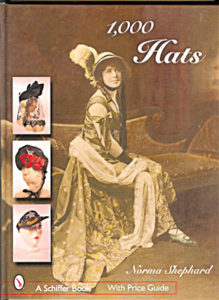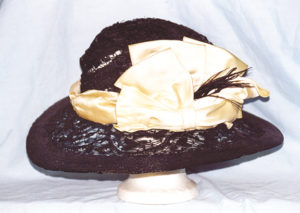 By Robert Reed
By Robert Reed While hats may not have the fashion status that they once had, there is no doubt that classic examples from the past are still pretty appealing even today.
From the fine Easter bonnet to the regal top hat they are admired and collected.
In decades long gone it was that special hat which invoked a certain feeling for the wearer. It caught the eye and stirred the soul.
“A hat was part sculpture, part architecture, part trimming and part craftsmanship,” according to LaRee Johnson Bruton, author of the book “Ladies Vintage Accessories.” “It was wearable art. It was a bouquet worn on our heads. And always a hat expressed emotion, especially when the wearer felt an affinity to that particular style.”
In terms of traditional wear the men’s top hat has one of the longest histories. As early as the 1790s the top hat was considered fashionable in England. Such hats made of silk, beaver or rabbit were well established in America by the 1820s and remained a symbol of upper-class status well into the next 20th century.
If the top hat was too formal, then the well-dressed male of the latter 19th century could chose the derby for most occasions. The dome-shaped derby, sometimes called a bowler, became popular in the 1870s. Its stiff felt rounded crown and curled brim, like the top hat, had strong British origins.
Basically the top hat and the derby became part of the dapper dress of the wealthy class of American males during the last few decades of the 19th century and the first few of the 20th century. Meanwhile working-class males generally wore soft caps that could be fitted in the pocket when not in use.
Women’s hats took a different transition in the 19th century, going from mere bonnet to fancy decor. Research by the prestigious Museums at Stony Brook (New York) suggests that even by the 1870s women’s hats tended to be little more than small, pushed forward bonnet-like affairs which attached beneath the chin. In terms of style little had changed in the previous half century.
However there were some relatively dramatic changes during the final two decades of the 19th century regarding women’s hats. For one thing, the technology for mass production and consequent marketing (department stores and mail-order catalogs) made more elaborate hats available and desirable. Additionally the economy of that era managed to elevate many more American families into the nation’s middle- and upper-class regions. An thus fashionable headwear became a significant statement about late 19th century prosperity.
“Emphasizing ornamentation and leisure as marks of fashion and success, ribbons, beads, lace, flowers, feathers and even whole birds adorned a variety of hat styles, shapes and sizes,” noted the experts at Stony Brook during a major exhibition of such top items.
Spring and summer women’s hats of the 1880s were simply breathtaking.
In 1886 the very trendy Bloomingdale’s catalog from New York City featured a striking selection of hats for the ladies. No longer were they slight and modest, instead they were boldly decorated with regal names to match. Choices included the Carmen, Lilly, Queen, Cappello, Woodland, Julia and the Avenue. The Avenue came with “fine Milan straw” and was further enchanted with velvet, jet and colored crepe. The Carmen came with tan colored lace, velvet ribbons and long showy plumes of exotic bird feathers.
 Such elaborate hats for the ladies were not inexpensive. Some of Bloomingdale’s better selections cost any where from $5 to $7 at a time when the average American worker’s annual wage was in the neighborhood of $500.
Such elaborate hats for the ladies were not inexpensive. Some of Bloomingdale’s better selections cost any where from $5 to $7 at a time when the average American worker’s annual wage was in the neighborhood of $500. Meanwhile the best-dressed men of the 1880s were wearing mostly bounder or derby hats with their Single-Breasted Fly Front Overcoats and Prince Albert suits. Catalogs and department stores offered top hats and even cloth caps as well, but for the most part the stiff and durable derby prevailed.
By the late 1890s the less stiff fedora hat had surpassed nearly all others in men’s wear. The Montgomery Ward and Company proclaims, “for ease, comfort and style the soft fedora leads all others. They are by far the most popular hats in the world today.” Men with more diverse tastes could also order a wide-brimmed planter’s, cowboy hats or the standard stiff fur derby-type models.
For women in midst of the same decade the message was clear, just mail-order the hat of your dreams. The millinery department of the mighty Montgomery and Ward boasted to their lady customers:
“We can furnish any style of trimmed or untrimmed hats in any desired quality or cost. We also carry in stock a full line of ribbons, fancy flowers, wreaths, sprays, Ostrich tips, plumes, birds and jetted ornaments. A reasonable charge will be made for trimming from 15 cents to 50 cents. Any hat or bonnet made or trimmed to order cannot be returned or exchanged.”
One of their best sellers at the time was the Venice Bonnet with its fine and fancy braid, velvet facing, small velvet flowers and wide silk lace. Even in spring and summer the only color the Venice Bonnet came in was basic black.
Fashion style for women at the dawn of the 20th century demanded larger and even more ornamented hats that before. The backward thrusting bustle was over and the narrow-waist fuller-bosomed look was beginning.
The unwieldy women’s hats of the early 1900s “complemented the top-heavy appearance and proclaimed the wearer’s wealth and gentility,” noted The Museums during their exhibition.
While the ostrich feather or plume was applied before the 20th century, it now became a central part of the most stylish dress hats for women.
Sears and Roebuck advertised “Real French Curl Plumes” in 1908 which were simply very elaborate ostrich feathers. They offered what the company proudly proclaimed was “a striking and harmonious combination of colors on a splendid hat.” There were dozens of illustrations in their catalogs, “which are made from actual photographs of each hat.” On the other hand the mail-order company would only go so far with hat fashion, declaring flatly, “we do not make or sell freak styles.”
Men of the early 1900s meanwhile would eventually find alternatives to the derby and top in the homburg which was named for a German resort. Typically the homburg was offered only in gray, black or dark blue. In later years it was available fairly widely in various colors. Another choice for men was the Panama. While the hat drew its name from Panama Canal workers who favored it, it was a crest top hat which likely had its origins in other parts of Central America.
Grand hats of the previous decades were pretty much gone for well-dressed women in the 1920s. Large was replaced by small in hat styles for ladies. Close-fitting bell-shaped hats were now in vogue to accommodate shorter “boyish” hair styles. By the 1930s women were attracted to the high fashion of even more curved lines in hats and glitzy selections which ranged from turbans and flowered hats to felt “change-about” hats which looked very much like a gentlemen’s fedora.
The fedora for men had become the most popular and most versatile dress hat on the market in the 1930s. The felt fedora was changeable because the medium-width brim could be snapped up or down depending on personal taste. The fedora continued to appeal to the businessman for decades.
Women’s hats meanwhile took a turn toward even more artificial flowers and synthetic materials during the 1940s and 1950. Still they remained on the smaller side and without undue embellishment. In the 1950s the so-called pill box hats became fashionable, along with higher crowned brimless hats. Overall small and round remained the style of choice.
Historians point to the 1960s as the sunset of the great age of women’s hats. After that period stylists put more emphasis on hairstyles themselves and had less regard for the lady’s hat as a symbol of status.
“Despite the persistent appearance of hats for formal occasion and despite Jacqueline Kennedy’s dignified and elegant pill boxes,” concluded The Museums at Stony Brook, “hats were relegated to whimsy and novelty, losing their long-standing place at the head of fashion.”
Recommended reading: “Ladies Vintage Accessories” by LaRee Johnson Bruton (Collector Books). captions Sweeping hat adorns lavishly dressed Evelyn Nesbit, ca. 1905. (New-York Historical Society). Dobbs Fifth Avenue box for dress hat. Men’s traditional straw hat, ca. 1920s. Woman’s hat with silk bow, black lace, ca. 1900s. Woman’s tight-fitting cap-like hat, ca. 1920s. Woman’s hat with pink bow, artificial flowers, ca. 1890s. Stylish spring and summer hats from early 1900s Sears catalog.
Vintage Hat Volume Tops Over 1,000 Choices
A hat is not just a hat to a collector. It is a treasure from the past.
That’s the clear message from the comprehensive book 1,000 Hats by Norma Shephard. Actually the author provides illustrations and information on over 1,200 vintage hats.
Antique hats are now available though estate sales, auctions, internet sites, antique stores, and charity shops according to Shephard.
“This was not always the case,” according to the author. “As recently as a decade ago, antique dealers discarded many lovely vintage hats as they could find a market for their boxes and trims only. Many report that they harvested feathers from old hats for resale to fly fisherman.”
Shephard, a traveling curator with the Mobile Millinery Museum, adds, “even mainstream museums turned away lovingly preserved hats, leaving theatre groups to benefit from donations.”
The book includes chapters on historic eras of hats including the Victorian period, the Flappers of the 1920s, the dignified beauty of the 1930s, the war and postwar ingenuity of the 1940s and 1950s, the end of an age through the 1960s. Chapters on the 1970s and 1980s deal with the demise and ultimate return of millinery.
When shopping for vintage millinery, a savvy collector will be able to distinguish between an authentic period piece and a reproduction according to Shephard. For example, “an original Victorian or Edwardian hat, though lavishly trimmed will possess an intangible air of softness. Reproductions on the other hand are often harsh and overdone. Reproductions may also feel stiff, revealing no signs of having been previously worn.” Included in the book are the works of major milliners including John B. Stetson, Tress and Company, Elsa Schiaparelli, Lilly Dache, Christian Dior, Laddie Northridge, Frank Olive, and Hattie Carnegie.
Additionally the volume includes sections on Ascot hats, Christmas hats, feathered hats, nursing hats, red hats, wedding hats, and more.
All along the way are hundreds of richly done illustrations and an equal amount of corresponding values. 1,000 Hats by Norma Shephard, hardcover, color photos, index, 256 pages, is from Schiffer Publishing, 4880 Lower Valley Rd., Atglen, PA 19310.















Follow Us